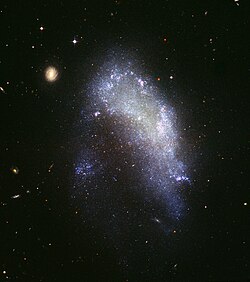
An irregular galaxy is a galaxy that does not have a distinct regular shape, unlike a spiral or an elliptical galaxy. [1] Irregular galaxies do not fall into any of the regular classes of the Hubble sequence, and they are often chaotic in appearance, with neither a nuclear bulge nor any trace of spiral arm structure. [2] This absence of structure in an irregular galaxy leads to little density waves in these galaxies. This makes irregular galaxies prime areas to study star formation without the effects of density waves. [3]
Contents
Collectively they are thought to make up about a quarter of all galaxies. [4] Some irregular galaxies were once spiral or elliptical galaxies but were deformed by an uneven external gravitational force. Irregular galaxies may contain abundant amounts of gas and dust. [5] This is not necessarily true for dwarf irregulars. [6] Irregular galaxies may also be formed in galaxy collisions. [7]
Irregular galaxies are commonly small, about one tenth the mass of the Milky Way galaxy, though there are also unusual cases of large irregulars like UGC 6697. Due to their small sizes, they are prone to environmental effects like colliding with large galaxies and intergalactic clouds. [8]








